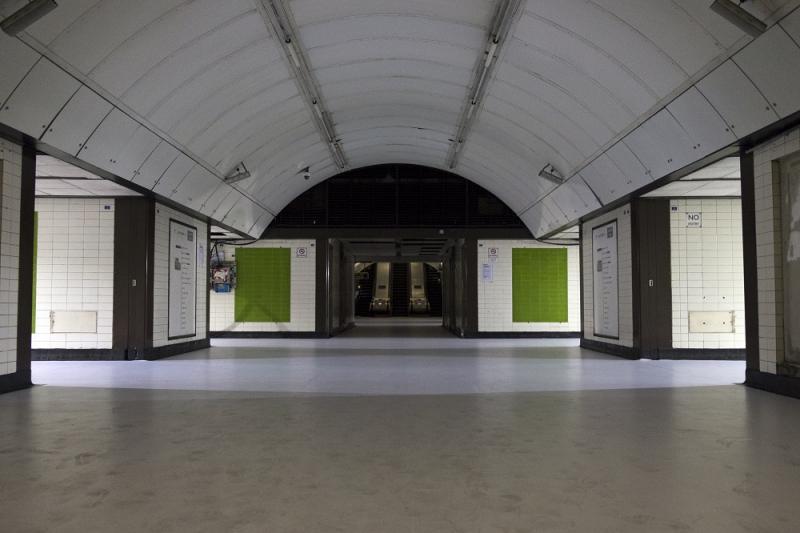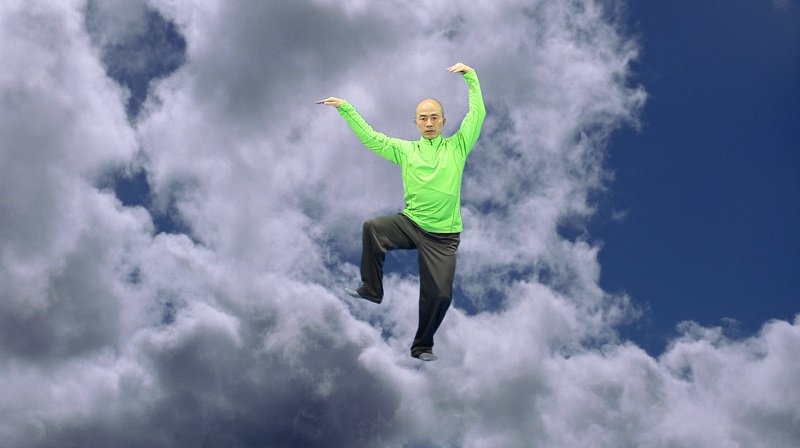Art Night London | reviews, news & interviews
Art Night London
Art Night London
The first edition of the capital's annual all-night art festival brought light in dark times

Just a few hours earlier, as helicopters clattered overhead and thousands joined the good-humoured but impassioned March for Europe, an evening of contemporary art felt like the last thing anyone needed. On this day of all days, launching an art festival inspired by the success of Nuit Blanche in Paris felt like an unnecessary application of salt to the wound.
People who had had enough of the march on Saturday found themselves drifting away from Whitehall, towards the Mall and the ICA, where a stage and sound system was being constructed for an epic, evening-long performance piece by British artist Linder. As protesters thronged along Pall Mall it was easy to assume that the sound system being put together on the Duke of York steps was connected with the demonstration, and around it rose a crescendo of the staple chant, “EU, WE LOVE YOU!”.
The occasional whisper of oud escaped to mix with the foul smells of one of London’s filthiest stationWith the heart of the event in Westminster, a number of the installations were located around Trafalgar Square, and seemed to absorb and react to the sense of crisis in the air. In the crowded ticket hall at Charing Cross Underground station, as a group of us were issued with fluorescent green wristbands and numbered stickers, I wondered what sort of subterranean nightmare was about to unfold. Tube stations, so often the focus of anxiety about terrorist attacks in the city, seem synonymous with threat.
And yet, as we descended the stairs to the platforms, we were met with the glorious, exotic scent of oud. It is a strange smell, because while it is entirely natural, it is remarkably strong, and familiar because of its use in perfumes. It seemed to change too, sometimes cloying and then a moment later fresh and invigorating, and its effect on the empty Jubilee Line platforms (main picture), out of use for some 20 years now, was transformative. Carefully lit, the floor painted white in areas, it was no longer anchored in space and time: it was almost as if we had journeyed upwards, above ground, not down. And while these platforms have been disused since the Nineties, they looked perfectly, disarmingly, familiar. As we emerged from this strange other world, the occasional whisper of oud escaped to mix with the foul smells of one of London’s filthiest stations, like odd snatches from a half-remembered dream.
 If Koo Jeong A’s sensory installation at Charing Cross defied expectations about an apparently limited, clearly-defined space, 2013 Turner Prize-winner Laure Provost’s After After, inside Admiralty Arch, played to our darkest suspicions about the rot at the heart of the British establishment. Queuing to get in we were asked by an agitated man with carrier bags wrapped round his ankles if we had “seen Betty” – was this part of the performance? A scatty and put-upon “guide” left us standing in a dark corridor, our minds set spinning as glimpses through half-opened doors set about confusing and disorienting us. The door to a sleazily blue-lit room opened, and a woman asked us if we’d like a drink. The room stank of fish, and she handed round shot glasses of “vodka and squid”, politely informing us that she used to work for John Lewis. I’ve never been so glad to get out in my life, but what an exhilarating piece of theatre it was.
If Koo Jeong A’s sensory installation at Charing Cross defied expectations about an apparently limited, clearly-defined space, 2013 Turner Prize-winner Laure Provost’s After After, inside Admiralty Arch, played to our darkest suspicions about the rot at the heart of the British establishment. Queuing to get in we were asked by an agitated man with carrier bags wrapped round his ankles if we had “seen Betty” – was this part of the performance? A scatty and put-upon “guide” left us standing in a dark corridor, our minds set spinning as glimpses through half-opened doors set about confusing and disorienting us. The door to a sleazily blue-lit room opened, and a woman asked us if we’d like a drink. The room stank of fish, and she handed round shot glasses of “vodka and squid”, politely informing us that she used to work for John Lewis. I’ve never been so glad to get out in my life, but what an exhilarating piece of theatre it was.
As Linder’s durational performance Destination Moon. You must not look at her! got going on the Duke of York steps, members of the 60-strong cast had donned sensible plastic rain capes, as we were deluged by yet another torrential downpour. The crowd seemed optimistic, the night was yet young. And as free performances and installations from internationally-acclaimed artists began at Covent Garden, Somerset House and Southwark Cathedral, London felt suddenly a little less lost, and a little bit closer to Europe once again (pictured above: Xu Zhen at Somerset House).
rating
Share this article
The future of Arts Journalism
You can stop theartsdesk.com closing!
We urgently need financing to survive. Our fundraising drive has thus far raised £49,000 but we need to reach £100,000 or we will be forced to close. Please contribute here: https://gofund.me/c3f6033d
And if you can forward this information to anyone who might assist, we’d be grateful.

Subscribe to theartsdesk.com
Thank you for continuing to read our work on theartsdesk.com. For unlimited access to every article in its entirety, including our archive of more than 15,000 pieces, we're asking for £5 per month or £40 per year. We feel it's a very good deal, and hope you do too.
To take a subscription now simply click here.
And if you're looking for that extra gift for a friend or family member, why not treat them to a theartsdesk.com gift subscription?
more Visual arts
 'We are bowled over!' Thank you for your messages of love and support
Much-appreciated words of commendation from readers and the cultural community
'We are bowled over!' Thank you for your messages of love and support
Much-appreciated words of commendation from readers and the cultural community
![SEX MONEY RACE RELIGION [2016] by Gilbert and George. Installation shot of Gilbert & George 21ST CENTURY PICTURES Hayward Gallery](https://theartsdesk.com/sites/default/files/styles/thumbnail/public/mastimages/Gilbert%20%26%20George_%2021ST%20CENTURY%20PICTURES.%20SEX%20MONEY%20RACE%20RELIGION%20%5B2016%5D.%20Photo_%20Mark%20Blower.%20Courtesy%20of%20the%20Gilbert%20%26%20George%20and%20the%20Hayward%20Gallery._0.jpg?itok=7tVsLyR-) Gilbert & George, 21st Century Pictures, Hayward Gallery review - brash, bright and not so beautiful
The couple's coloured photomontages shout louder than ever, causing sensory overload
Gilbert & George, 21st Century Pictures, Hayward Gallery review - brash, bright and not so beautiful
The couple's coloured photomontages shout louder than ever, causing sensory overload
 Lee Miller, Tate Britain review - an extraordinary career that remains an enigma
Fashion photographer, artist or war reporter; will the real Lee Miller please step forward?
Lee Miller, Tate Britain review - an extraordinary career that remains an enigma
Fashion photographer, artist or war reporter; will the real Lee Miller please step forward?
 Kerry James Marshall: The Histories, Royal Academy review - a triumphant celebration of blackness
Room after room of glorious paintings
Kerry James Marshall: The Histories, Royal Academy review - a triumphant celebration of blackness
Room after room of glorious paintings
 Folkestone Triennial 2025 - landscape, seascape, art lovers' escape
Locally rooted festival brings home many but not all global concerns
Folkestone Triennial 2025 - landscape, seascape, art lovers' escape
Locally rooted festival brings home many but not all global concerns
 Sir Brian Clarke (1953-2025) - a personal tribute
Remembering an artist with a gift for the transcendent
Sir Brian Clarke (1953-2025) - a personal tribute
Remembering an artist with a gift for the transcendent
 Emily Kam Kngwarray, Tate Modern review - glimpses of another world
Pictures that are an affirmation of belonging
Emily Kam Kngwarray, Tate Modern review - glimpses of another world
Pictures that are an affirmation of belonging
 Kiefer / Van Gogh, Royal Academy review - a pairing of opposites
Small scale intensity meets large scale melodrama
Kiefer / Van Gogh, Royal Academy review - a pairing of opposites
Small scale intensity meets large scale melodrama
 Jenny Saville: The Anatomy of Painting, National Portrait Gallery review - a protégé losing her way
A brilliant painter in search of a worthwhile subject
Jenny Saville: The Anatomy of Painting, National Portrait Gallery review - a protégé losing her way
A brilliant painter in search of a worthwhile subject
 Abstract Erotic, Courtauld Gallery review - sculpture that is sensuous, funny and subversive
Testing the boundaries of good taste, and winning
Abstract Erotic, Courtauld Gallery review - sculpture that is sensuous, funny and subversive
Testing the boundaries of good taste, and winning
 Edward Burra, Tate Britain review - watercolour made mainstream
Social satire with a nasty bite
Edward Burra, Tate Britain review - watercolour made mainstream
Social satire with a nasty bite
 Ithell Colquhoun, Tate Britain review - revelations of a weird and wonderful world
Emanations from the unconscious
Ithell Colquhoun, Tate Britain review - revelations of a weird and wonderful world
Emanations from the unconscious

Add comment